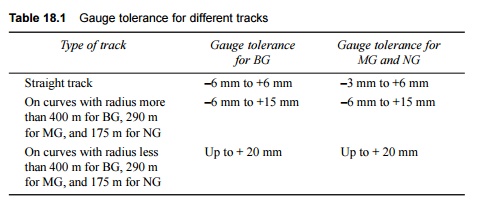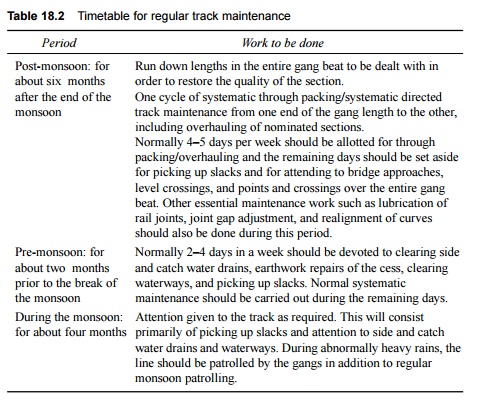Chapter: Civil : Railway Airport Harbour Engineering : Railway Engineering : Track Maintenance
Essentials of Track Maintenance
Essentials of Track Maintenance
As mentioned earlier, a
well-maintained track provides the base for a safe and comfortable journey.
Therefore, for a track to serve its purpose well, the following characteristics
are required of it.
(a) The gauge
should be correct or within the specified limits
(b) There
should be no difference in cross levels except on curves, where cross levels
vary in order to provide superelevation
(c) Longitudinal
levels should be uniform
(d) The
alignment should be straight and kink-free
(e) The
ballast should be adequate and the sleepers should be well packed.
(f) There
should be no excessive wear and tear of the track and all its components and
fittings should be complete.
(g) Track
drainage should be good and the formation should be well maintained. To achieve
these standards, the major maintenance operations performed in a
calendar year are described in the following sections.
1. Through Packing
Through packing is carried out in
a systematic and sequential manner as described here.
Opening of road The
ballast is dug out on either side of the rail seat for a depth of 50 mm
(2") below the bottom of the sleeper with the help of a shovel with a wire
claw. On the outside, the width of the opening should extend up to the end of
the sleeper. On the inside, it should extend from the rail seat to a distance
of 450 mm (18") in the case of BG, 350 mm (14") in the case of MG,
and 250 mm (10") in the case of NG.
Examination of rails, sleepers,
and fastenings The rails, sleepers, and fastenings to be
used are thoroughly examined. Defective sleepers are removed and loose
fastenings are tightened. Any kinks in the rails are removed using a Jim Crow.
Squaring of sleepers The
sleepers get out of square quite frequently resulting in gauge
variations and kinks. To avoid this, one of the rails is taken as the sighting
rail and the correct sleeper spacing is marked on it. The position of the
sleeper is checked with reference to the second rail with the help of a
T-square. The sleepers are attended to after their defects have been
established, which may include their being out of square or at incorrect
spacing.
Aligning the track The
alignment of the track is normally checked visually, wherein the rail is
visually assessed from a distance of about four rail lengths or so. Small
errors in the alignment are corrected by slewing the track after loosening the
cores at the ends and drawing out sufficient ballast at the end of the
sleepers. Slewing is carried out by about six people by planting crowbars deep
into the ballast at an angle not exceeding 30 o from the vertical.
Gauging The gauge
should be checked and an attempt should be made to provide a uniform
gauge within permissible tolerance limits. Table 18.1 lists the tolerances
prescribed for gauge variation, keeping in mind the side wear that occurs at
the time of laying of tracks. This is done to ensure a comfortable ride for the
passengers, provided that uniform gauge can be maintained over long lengths.
Table
18.1 Gauge tolerance
for different tracks

The gauge is adjusted in
accordance with the type of sleeper under consideration as described in the
following.
Wooden sleepers In the
case of wooden sleepers, gauge adjustment is possible only by
removing the dog spikes and refitting them at a new location. Therefore, gauge
adjustment should be avoided as far as possible unless the gauge is quiet
irregular. When the gauge must be adjusted, all the spikes on the inside and
half of those on the outside are removed while the remaining half are loosened.
The old spike holes are plugged and new holes are bored in correct places. The
gauge on each sleeper is adjusted and the spikes are re-driven.
Steel trough sleepers In the
case of steel trough sleepers, gauge adjustment is done with the
help of keys. When the gauge is slack, the keys on the inside are loosened
while those on the outside are driven. The procedure is reversed when the gauge
is tight. The maximum possible adjustment of the gauge is 2.5 mm to +4.0 mm.
CST-9 sleepers In the
case of CST-9 sleepers, gauge adjustment is done with the help of
cotters. Normally a gauge is adjusted by ±5 mm. The maximum extent to which a
gauge can be adjusted -3 mm to +10 mm. It has been noticed that adjusting the
gauge may sometimes disturb the alignment, which is taken care of prior to gauging
as per the standard practice. In such cases, the track has to be realigned once
gauging is completed.
Packing of sleepers
The base rail is identified by
the mate and the dip or low joints are lifted correctly to ensure that the
longitudinal level of the rail is perfect. The sleepers are then packed by
applying the scissors packing method. Four men tackle one sleeper
simultaneously, two at each rail. The ballast under the sleeper bed is properly
packed by the men who stand back to back and work their beaters diagonally by
lifting them up to chest level. While the packing is being carried out, the
second rail is brought to the correct cross levels thereby ensuring perfect
surfacing of the track. In the case of wooden and steel trough sleepers, it
should be ensured that the sleepers are not centre-bound and that as such the
trough is made in the ballast section at the centre of the sleepers. After
packing is completed, the alignment and top should be checked carefully and
minor adjustments made as needed.
Repacking of joint sleepers The joint
sleepers are then packed once again and the cross levels checked.
Boxing ballast section and
dressing Afterwards the ballast section is properly boxed and
dressed with the help of a special template. The cess should also be dressed or
covered similarly and its level maintained in a way that proper drainage is
ensured. Through packing follows a programme which requires that it is
undertaken after the monsoon and that it extends from one end of the section to
the other. Through packing must be carried out at least once every year.
A gangman normally accomplishes
about 11 m to 12 m of through packing on BG, 16 m to 17 m on MG, and 23 m to 24
m on NG tracks.
2 Systematic Overhauling
The track should be overhauled
periodically with the object of ensuring that the best possible standards of
track conditions are met and maintained. The systematic overhauling of the
track should normally commence after the completion of one cycle of through
packing. It involves the following operations in sequence.
(a) Shallow
screening and making up of ballast section
(b) Replacement
of damaged or broken fittings
(c) All items
included in through packing
(d) Making up
the cess
The frequency of overhauling
depends upon a number of factors such as the type and age of track structure,
the maximum permissible speed and volume of traffic, the mode of traffic, the
mode of traction, the rate of track deterioration, and the amount of rainfall
in the region. On the basis of these factors the chief engineer decides, the
length of the track to be overhauled but normally the plan is so drawn that the
systematic overhauling of a section is completed in about 3 to 4 years. The
stretch of track to be tackled in a particular year should be in continuation
of the length overhauled during the previous year. If possible, gap adjustment,
including joint survey and adjustment of creep, should be done prior to
systematic overhauling.
Lubrication of rail joints
The lubrication of rail joints is
an important part of the work done on the permanent way and is incidental to
systematic track maintenance. Joints are lubricated for the following purposes.
(a) To allow
for free expansion and contraction of rail
(b) To reduce
wear and tear on the fishing planes of rails and the fish plates All rail
joints, are lubricated once a year during the moderate season. This is
also known as the oiling and
greasing of fish plates. This work is not done during the rainy season. The
lubricant used is a paste of workable consistency that consists of the
following proportions of plumbago, kerosene oil, and black oil.
Plumbago (dry graphite) 5 kg Kerosene oil (second quality) 3.5
L Black or reclaimed oil 2.75 L
For 100 joints of 52 kg/90 R or
for 125 joints of 75 R/90 R sometimes only plumbago and kerosene oil are used
in the ratio of 3:2 for lubricating fish plates. Black oil is, however, used
for oiling fish bolts and nuts.
Rail joints should be lubricated
only after ensuring that their surfaces are properly cleaned, preferably with
the help of wire brushes and clean jute. Joints should not be lubricated in
extreme temperatures or when the rails are in tension as a result of creep.
Joints should be opened one at a time for lubrication. Even when opening a
joint, only one fish plate should be tackled at a time and at no time during
the operation should there be less than one fish plate and three fish bolts
connecting the two rails.
3 Picking up Slacks
Slacks are those points in the
track where the running of trains is faulty or substandard. Slacks generally
occur in the following cases.
(a) Stretches
of yielding formation
(b) Poorly
maintained sections that have loose packing, bad alignment, and improper
longitudinal and cross levels
(c) Improperly
aligned curves
(d) Approaches
to level crossings, girder bridges, etc., particularly in sags
(e) Portions
of track with poor drainage
(f) Sections
with an inadequate or unclean ballast cushion
(g) Other
miscellaneous reasons
In every
working season, a certain number of days in each week (normally one or two
days) are allotted to the picking up of slacks, depending upon the monsoon
pattern and other local conditions. However, no through packing is done during
the rainy season and slacks are only picked up in order to keep the track safe
and in good running condition. In areas with less than 750 mm of rainfall, the
alloted time may not be used only to attend to the slack but also to carry out
through packing.
Slack may be sometimes picked up
by packing only the following segments of the track.
(a) Joint
sleepers and the two other sleepers on either side of the joint, i.e., first
shoulder and second shoulder sleepers
(b) A few
sleepers in the approaches to level crossings and bridges
(c) Intermediate
sleepers
(d) Stretches
of track that adversely affect the running of trains as revealed by inspection
notes
It may be noted here that points
and crossings should be attended to throughout the year. In sections with no
points and crossings, the alloted time may be utilized for creep adjustment and
other such track maintenance work. Two separate charts, one for main line work
and another for yard work, are maintained by each gang and kept in the personal
custody of the gang mate.
A recommended annual programme is
drafted for regular track maintenance, in which each major activity is
specified a certain time slot as per a fixed timetable (calendar). Table 18.2
shows the timetable for regular track maintenance. Concrete sleeper tracks are
maintained by on-track tie tamping machines. Details of the annual programme
drawn up for the maintenance of concrete sleeper tracks are given in Chapter
20.
Table
18.2 Timetable for
regular track maintenance

Related Topics